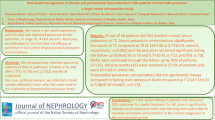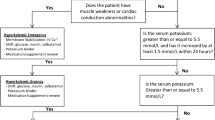Abstract
Patiromer (Veltassa™) for oral suspension is a sodium-free potassium binder that is approved in the USA for the treatment of hyperkalaemia. In clinical trials, patiromer significantly reduced serum potassium levels from baseline to week 4 in patients with chronic kidney disease (CKD) and mild to severe hyperkalaemia (OPAL-HK), or CKD, mild to moderate hyperkalaemia and type 2 diabetes mellitus (AMETHYST-DN), who were receiving renin-angiotensin-aldosterone system inhibitors (RAASis; drugs that inhibit the renal excretion of potassium). Among patients in OPAL-HK who had moderate to severe hyperkalaemia at baseline and normokalaemia on patiromer and RAASis at week 4, continuing patiromer for a further 8 weeks maintained reductions in potassium levels more effectively than switching to placebo (i.e. withdrawing patiromer); consequently, fewer patiromer than placebo recipients experienced recurrent hyperkalaemia during this period. Furthermore, almost all patiromer (vs. less than half of placebo) recipients were still receiving RAASi therapy at the end of this trial. In AMETHYST-DN, the significant reduction from baseline in serum potassium levels seen at week 4 was sustained for up to 52 weeks. Patiromer was generally well tolerated in these trials, with no treatment-related serious adverse events or deaths. Commonly occurring treatment-related adverse events include mild to moderate constipation and hypomagnesaemia, and there is a low risk of hypokalaemia. In conclusion, oral patiromer is a useful new option for patients with hyperkalaemia.
Similar content being viewed by others
References
Lehnhardt A, Kemper MJ. Pathogenesis, diagnosis and management of hyperkalemia. Pediatr Nephrol. 2011;26(3):377–84.
Kovesdy CP. Management of hyperkalemia: an update for the internist. Am J Med. 2015;128(12):1281–7.
UK Renal Association. Clinical practice guidelines: treatment of acute hyperkalaemia in adults. 2014. http://www.renal.org. Accessed 27 June 2016.
National Kidney Foundation. Clinical update on hyperkalemia: a chronic risk for CKD patients and a potential barrier to recommended CKD treatment. 2014. https://www.kidney.org. Accessed 27 June 2016.
Hollander-Rodriguez JC, Calvert JF Jr. Hyperkalemia. Am Fam Physician. 2006;73(2):283–90.
Batlle D, Boobés K, Manjee KG. The colon as the potassium target: entering the colonic age of hyperkalemia treatment? EBioMedicine. 2015;2(11):1562–3.
Epstein M, Reaven NL, Funk SE, et al. Evaluation of the treatment gap between clinical guidelines and the utilization of renin-angiotensin-aldosterone system inhibitors. Am J Manag Care. 2015;21(Suppl 11):s212–20.
Kovesdy CP. Management of hyperkalaemia in chronic kidney disease. Nat Rev Nephrol. 2014;10(11):653–62.
Packham DK, Kosiborod M. Potential new agents for the management of hyperkalemia. Am J Cardiovasc Drugs. 2016;16(1):19–31.
US FDA. Veltassa™ (patiromer) for oral suspension: US prescribing information. 2016. http://www.fda.gov. Accessed 27 June 2016.
Li L, Harrison SD, Cope MJ, et al. Mechanism of action and pharmacology of patiromer, a nonabsorbed cross-linked polymer that lowers serum potassium concentration in patients with hyperkalemia. J Cardiovasc Pharmacol Ther. 2016;. doi:10.1177/1074248416629549.
US FDA. Veltassa™ (patiromer) medical review. 2015. http://www.fda.gov. Accessed 27 June 2016.
Epstein M, Palmer B, Mayo M, et al. Mechanism of action of patiromer for oral suspension: increases fecal K+ excretion in healthy subjects independent of race [abstract no. SAT-218 plus poster]. In: World Congress of Nephrology; 2015.
Bushinsky D, Spiegel D, Gross C, et al. Effect of patiromer on urine calcium and phosphate excretion in healthy adults [abstract no. 309 plus poster]. In: National Kidney Foundation Spring Clinical Meeting; 2016.
Bakris GL, Pitt B, Weir MR, et al. Effect of patiromer on serum potassium level in patients with hyperkalemia and diabetic kidney disease: the AMETHYST-DN randomized clinical trial. JAMA. 2015;314(2):151–61.
Bushinsky DA, Williams GH, Pitt B, et al. Patiromer induces rapid and sustained potassium lowering in patients with chronic kidney disease and hyperkalemia. Kidney Int. 2015;88(6):1427–33.
Weir MR, Bakris GL, Bushinsky DA, et al. Patiromer in patients with kidney disease and hyperkalemia receiving RAAS inhibitors. N Engl J Med. 2015;372(3):211–21.
Weir MR, Bakris GL, Gross C, et al. Treatment with patiromer decreases aldosterone in patients with chronic kidney disease and hyperkalaemia on renin-angiotensin system inhibitors. Kidney Int. 2016;. doi:10.1016/j.kint.2016.04.019.
US FDA. Veltassa™ (patiromer) clinical pharmacology biopharmaceutics review(s). 2014. http://www.fda.gov. Accessed 27 June 2016.
Cope J, Ciaravino V, Du X, et al. A new, effective, non-absorbed, therapeutic polymer to control serum potassium [abstract no. F-PO1616]. J Am Soc Nephrol. 2010;21(Suppl):483A.
Relypsa. Relypsa announces results from Veltassa drug-drug interaction studies in healthy volunteers [media release]. 25 Jan 2016. http://www.relypsa.com.
Weir M, Bushinsky D, Mayo M, et al. Patiromer reduced recurrent hyperkalemia in advanced CKD patients on RAASI [abstract no. 301]. Am J Kidney Dis. 2015;65(4):A90.
Weir M, Bakris GL, Mayo M, et al. Patiromer lowered serum K+ in hyperkalemic patients with diabetic kidney disease on RAAS inhibitors [abstract no. 1305-P]. Diabetes. 2015;64(Suppl 1):A339.
Weir MR, Mayo M, Garza D, et al. Chronic diuretic therapy does not impair the effectiveness of patiromer in hyperkalemic patients with CKD [abstract no. TH-PO658]. J Am Soc Nephrol. 2015;26(Abstract Suppl):240A.
Bakris G, Pitt B, Mayo M, et al. Reduction of serum K+ with patiromer for 1 year in patients with diabetic CKD who developed hyperkalemia while on maximal losartan and/or spironolactone [abstract no. P-126]. J Am Soc Hypertens. 2015;9(Suppl 4):e75–83.
Pitt B, Bushinsky D, Garza D, et al. 1-year safety and efficacy of patiromer for hyperkalemia in heart failure patients with chronic kidney disease on renin-angiotensin-aldosterone system inhibitors [abstract no. A855]. J Am Coll Cardiol. 2015;65(10 Suppl):A855.
Bakris G, Pitt B, Weir M, et al. Patiromer lowered serum potassium for up to 1 year in hyperkalemic patients with diabetes and advanced kidney disease on RAAS inhibitors [abstract no. SuO019]. Nephrol Dial Transplant. 2015;30(Suppl 3):iii51–2.
Epstein M, Mayo M, Garza D, et al. Patiromer controls hyperkalemia in resistant hypertensive patients on RAASi, with diabetic kidney disease [abstract no. 14271]. Circulation. 2015;132(Suppl 3).
Epstein M, Campese V, Mayo M, et al. Patiromer for oral suspension produces prompt and sustained reductions in serum K+ in CKD patients with moderate-to-severe hyperkalemia on RAAS inhibitors [abstract no. SAT-220 plus poster]. In: World Congress of Nephrology; 2015.
Epstein M, Palmer B, Mayo M, et al. Attainment of normal serum K+ range in CKD patients with moderate-to-severe hyperkalemia on RAAS inhibitors: clinical trial results with patiromer for oral suspension [abstract no. SAT-219 plus poster]. In: World Congress of Nephrology; 2015.
Weir M, Bushinsky D, Mayo M, et al. Patiromer lowers serum potassium in patients with elevated potassium and diabetes and advanced CKD on RAAS inhibitors: results from OPAL-HK and AMETHYST-DN [abstract no. 1110]. Diabetologia. 2015;58(Suppl 1):S533–4.
Pitt B, Weir M, Bushinsky DA, et al. Patiromer reduced serum K+ in hyperkalaemic patients with HF and advanced CKD on RAAS inhibitors: results from OPAL-HK and AMETHYST-DN [abstract no. P1799]. Eur Heart J. 2015;36(Suppl 1):318–9.
Pitt B, Weir M, Bushinsky D, et al. Patiromer reduces serum K+ in hyperkalemic patients with HF and CKD on RAAS inhibitors: results from OPAL-HK and AMETHYST-DN [abstract no. 253]. J Card Fail. 2015;21(8 Suppl):S107–8.
Weir MR, Bushinsky DA, Mayo M, et al. Patiromer lowers serum K+ and prevents recurrent hyperkalemia in CKD patients >65 years of age on RAAS inhibitors [abstract no. TH-OR035]. J Am Soc Nephrol. 2015;26(Abstract Suppl):10A.
Weir MR, Bakris GL, Bushinsky DA, et al. Patiromer lowers serum K+ and prevents recurrent hyperkalemia in patients with diabetes and CKD on RAAS inhibitors: subgroup results of a phase 3 trial [abstract no. FR-PO792]. J Am Soc Nephrol. 2014;25(Abstract Suppl):550–1A.
Weir M, Bushinsky D, Mayo M, et al. Patiromer lowers serum K+ and prevents recurrent hyperkalemia in CKD patients ≥65 years of age on RAAS inhibitors [abstract no. N02 plus poster]. J Manag Care Spec Pharm. 2016;22(4-a):S110–1.
Pitt B, Bakris GL, Bushinsky DA, et al. Effect of patiromer on reducing serum potassium and preventing recurrent hyperkalaemia in patients with heart failure and chronic kidney disease on RAAS inhibitors. Eur J Heart Fail. 2015;17(10):1057–65.
McCullough PA, Costanzo MR, Silver M, et al. Novel agents for the prevention and management of hyperkalemia. Rev Cardiovasc Med. 2015;16(2):140–55.
Sterns RH, Grieff M, Bernstein PL. Treatment of hyperkalemia: something old, something new. Kidney Int. 2016;89(3):546–54.
US FDA. FDA drug safety communication: FDA requires drug interaction studies with potassium-lowering drug Kayexalate (sodium polystyrene sulfonate). 2015. http://www.fda.gov. Accessed 27 June 2016.
Acknowledgments
During the peer review process, the manufacturer of patiromer was also offered an opportunity to review this article. Changes resulting from comments received were made on the basis of scientific and editorial merit.
Author information
Authors and Affiliations
Corresponding author
Ethics declarations
Funding
The preparation of this review was not supported by any external funding.
Conflict of interest
Esther Kim and Emma Deeks are salaried employees of Adis/Springer, are responsible for the article content and declare no relevant conflicts of interest.
Additional information
The manuscript was reviewed by: D. Batlle, Northwestern University Feinberg School of Medicine, Chicago, IL, USA; S. Shirazian, Division of Nephrology, Department of Medicine, Winthrop University Hospital, Mineola, NY, USA.
Rights and permissions
About this article
Cite this article
Kim, E.S., Deeks, E.D. Patiromer: A Review in Hyperkalaemia. Clin Drug Investig 36, 687–694 (2016). https://doi.org/10.1007/s40261-016-0432-9
Published:
Issue Date:
DOI: https://doi.org/10.1007/s40261-016-0432-9




